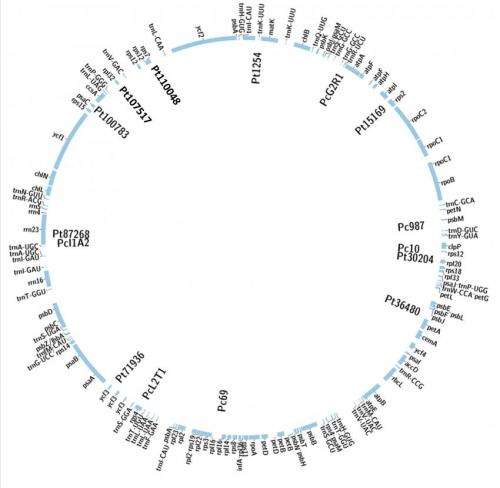Simple sequence repeats for population-level studies of pines

Simple sequence repeats, abbreviated SSRs and frequently referred to as microsatellites, are highly variable sections of the genome. 'Sequence repeat' refers to the fact that a nucleotide motif is repeated. 'Simple,' because the repeated sequence often consists of only a couple of nucleotides—for example, ATAT.
Because these markers typically have high rates of molecular evolution, the number of repeats present in the genome often differs between individuals. By isolating SSRs and comparing length differences between taxa, evolutionary relationships can be inferred. Their high rate of change makes these markers particularly useful for fine-scale studies aimed at uncovering genetic structure within and between populations of a single species.
Scientists at Hendrix College have determined the location of a set of SSR regions that were originally found in the chloroplast genome of two species of pines. They compared these regions in over 100 pine species and tested them using over 900 individuals. The results of their study are available for free viewing in the May issue of Applications in Plant Sciences.
"We compared published primer pairs with newly published plastomes for many species to select highly variable, unique fragments" says Dr. Ann Willyard, one of the authors of the study. "Additionally, by adopting a PCR multiplex technique that does not require primers to be fluorescently labeled for each locus, this approach is much more cost-effective than traditional methods."
Importantly, all loci used in this study were from the plastid genome. "Nuclear markers have historically been difficult to work with in pines," explains Willyard. "Although the nuclear genome is important to fully understand evolutionary relationships in plants, nuclear data sets are very difficult to obtain for large numbers of individuals and are complicated by issues of paralogy and shared ancestral polymorphisms, especially in long-lived outcrossing tree species like pines."
Willyard and her undergraduate colleagues tested the utility of these SSRs within groups of ponderosa pine. They found six markers to be particularly useful for understanding genetic structure within this group. By showing which primers were in conserved regions of the genome, they were able to suggest that many of these loci are likely to be useful in other groups.
"The ponderosa pine species complex was used as a test case, but the resources that we have presented will make the technique easily adaptable to any group of pine species," explains Willyard.
The SSR regions identified in this study provide a jumping-off point for future studies. "We are particularly excited about the usefulness of these markers for delimiting species complexes," says Willyard. "Because next-generation sequencing is still cost prohibitive for population-level studies, fragment lengths of SSRs provide a quick and inexpensive way to look for patterns that are worth pursuing and testing with next-generation nucleotide sequences for one exemplar from each population of interest."
Journal information: Applications in Plant Sciences
Provided by American Journal of Botany
















